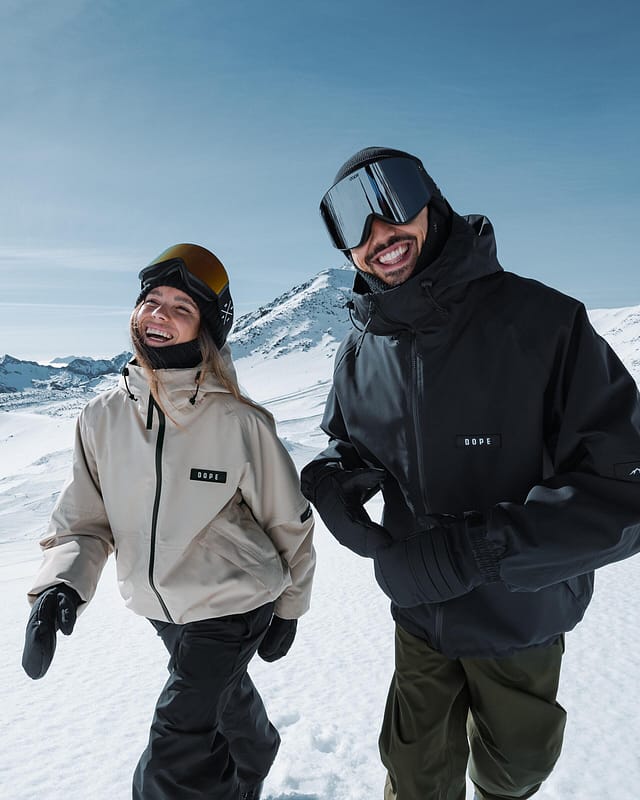How to choose the best snowboard jacket
When it comes to choosing the right snowboarding jacket, there are so many factors to consider. What kind of waterproof rating do you need? Insulated or shell? What about pockets, vents, and snow skirts? It’s all rounded up below. So dig those edges into our ultimate guide on how to choose a snowboard jacket and ride in style this year.

When looking for a new snowboarding jacket, you should ask yourself a couple of key questions. Once you have the answers, the choice becomes a lot easier. Don’t stress about the questions and answers, though. We’ve broken down what makes a great snowboard jacket and included our best choices for men and women so you can choose with confidence.
Your guide to the perfect snowboard jacket
The different types of snowboarding jackets
Waterproofing and breathability
Shell materials and membranes
Insulation types
Jacket fit
Key snow jacket features
Top 5 picks for men
Top 5 picks for women
The different types of snowboarding jackets

You’ll find there are different types of snowboarding jackets. While they all keep you warm and dry, some are better suited to certain conditions. And picking the right style for your riding makes a big difference on the mountain. So, let’s look at what’s out there:
Insulated jackets
Insulated jackets are the most popular option for snowboarders – and for good reason. They pack a layer of synthetic or down insulation between the waterproof shell and inner liner, which traps heat and keeps you warm even in freezing conditions. This makes them a great all-rounder, especially if you’re heading out in mid-winter or riding at higher altitudes where temperatures drop fast.
Beginners often find insulated jackets ideal, since you can throw one over a base layer without worrying too much about layering systems. It’s a simple yet effective way to stay warm and comfortable all day long.
Hardshell jackets
Hardshell jackets are built with performance in mind. They’re usually lighter than insulated jackets because they don’t have extra padding inside, which makes them more versatile for layering. Most hardshells come with higher waterproof ratings and better breathability. That’s because they’re designed to cope with heavy snow, rain, or even backcountry missions where you’ll be working up a sweat.
Because they’re lighter and more technical, hardshells are popular with advanced riders and anyone exploring outside resort boundaries. With a hardshell, you can stay cool when hiking, and throw on a midlayer for your ride down.
Softshell jackets
Softshell jackets are all about comfort and flexibility. They’re made from stretchy, breathable fabrics with a fleece backer. This makes them feel more like a cosy hoodie than a technical snow jacket. So, softshells are an excellent choice for warmer days, spring slush sessions, or cruising the park when you don’t need full-on protection from storms. But the comfort factor is huge, and many riders love them for their casual style and versatility around the resort.
Waterproofing and breathability

When choosing a snowboard jacket, waterproofing and breathability are two of the most important factors to think about. Waterproofing is measured in millimetres (mm). The higher the number, the longer it takes for water to get in. Breathability is measured in grams (g/m²/24hrs) and shows how much sweat vapour can escape. A good balance is key, because you need a jacket that keeps snow and rain out, but also lets heat and moisture escape when you start working hard.
For most riders, a 10,000 mm / 10,000 g (10k/10k) rating is the ideal balance, keeping you dry and comfortable in typical resort conditions. But if you ride in wetter climates or push things harder, 15k to 20k provides extra protection and performance when you need it most. It’s also worth looking for jackets with a DWR (durable water repellent) coating. This helps water bead up and roll off. Many modern DWRs are PTFE and PFAS-free, which is a big win for the environment, too.
Shell materials and membranes
Most snowboard jackets use either polyester or nylon as the main shell fabric, and both are solid choices. Polyester is tough, lightweight, and holds colour really well, while nylon is known for being extra durable and abrasion-resistant. The shell fabric itself is only the first line of defence, though. Or, the second, if you count the DWR treatment – which we do! The true ‘waterproofing’, however, comes from the membrane that sits behind the fabric.
Modern jackets use laminated membranes like TPU (thermoplastic polyurethane), which are bonded to the back of the shell. These membranes are microporous, meaning they block snow and rain, but still allow sweat vapour to pass through. This combination creates a barrier that’s both waterproof and breathable without feeling heavy or stiff.
Insulation types

Snowboard jackets generally use three main types of insulation: synthetic, synthetic down, and natural down. Down usually comes from ducks or geese and is incredibly warm and compressible. However, it’s expensive and loses much of its insulating power when wet, which makes it less practical in snowy or damp conditions. There are some ethical concerns surrounding down, too – just as there are with using fur. On the other hand, synthetic down mimics the loft and feel of natural down but holds up better in wet weather, is much cheaper, and doesn’t harm animals. This makes it a more versatile option for ski and snowboard gear with a lighter ethical price.
Most modern snowboard jackets, however, lean on synthetic insulation like Comfortemp® or Fellex®. These fibres are designed to trap heat efficiently while remaining lightweight and breathable. They dry quickly, pack down small, and retain warmth even when damp. This makes them perfect for long days in mixed conditions. Compact synthetic insulation offers the best balance of warmth-to-weight, durability, and all-weather reliability, making it the go-to choice for riders who need dependable performance without added bulk.
Jacket fit
When it comes to snowboard jackets, fit is a matter of personal preference. But having enough room to move is always key. Snowboarding involves constant bending, twisting, and stretching, so a jacket that feels too tight will quickly become uncomfortable. That’s why many riders opt for a slightly looser or oversized cut, as it allows for better freedom of movement and makes it easier to layer underneath.
Oversized fits are especially popular in modern snowwear for style and practicality. A loose jacket allows you to wear thicker midlayers on colder days without feeling restricted, and is still breathable and comfortable when you ride harder. On the other hand, some riders prefer a slimmer silhouette for a more streamlined feel. Ultimately, all comes down to what you prefer.
Key snow jacket features
The best snowboard jackets are the ones that come fully loaded. Technical features make the difference between being warm, dry, and comfortable all day, or cutting your session short. Here are the essentials to look for.
Hood
A good hood should be helmet-compatible and fully adjustable. This means you can cinch it down to keep out wind and snow when conditions turn rough, or loosen it off when the sun’s shining. Some brands often opt for a storm guard design. This adds even more protection and seals the face area without restricting movement or vision.
Snow skirt and wrist gaiters
Snow skirts and wrist gaiters are vital, especially if you like to venture into deeper snow. A snow skirt snaps around your waist to stop powder from going up inside your jacket if you take a tumble. Wrist gaiters work in the same way for your arms, sealing the gap between jacket and gloves.
Pockets and storage
Good snowboarding jackets have lots of storage. Look for waterproof outer pockets to keep your stuff dry, plus a lift pass pocket on the sleeve for quick scanning. Inside, dump pockets are awesome for stashing goggles or gloves, while media pouches keep electronics looked after.
Vents
Riding can be sweaty work. This is where underarm vent zips save the day. They let you release heat quickly without taking your jacket off, keeping your core temperature balanced. This is especially useful when hiking the park, bootpacking to sidecountry spots, or even when spring sun cranks up the heat.
Drawstring hem
A drawstring hem helps you lock in warmth and keep snow out when you’re riding deep or fast. It lets you tighten the bottom of your jacket to create a snug seal around your hips, stopping cold air or powder from sneaking in underneath. Plus, when the wind picks up on the lift or you take a tumble in fresh snow, you’ll be thankful for that extra bit of protection. And as a bonus, you can use it to style your jacket to your liking.
Top 5 picks for men
Choosing the right snowboard jacket is about finding the balance between warmth, protection, and style. Here are some of the best options from Dope Snow and Montec that deliver on all fronts.
Top 5 picks for women
Finding the right snowboard jacket is all about comfort, protection, and style. Here are our top picks from Dope Snow and Montec that deliver tech without compromising on performance or looks.
Wrapping up
Well, there you have it: our one-stop guide to choosing the best snowboarding jacket for your next trip. Whether it’s a backcountry-heavy adventure or a relaxed, cruisey trip to some choice après hotspots, having the right jacket is a must. Love this article or need more help? Hit us up at crew@ridestore.com to ask your burning questions.
Related reading:


















